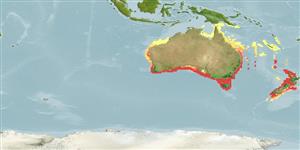>
Carangiformes (Jacks) >
Carangidae (Jacks and pompanos) > Caranginae
Etymology: Trachurus: Greek, trachys, -eia, -ys = rough + Greek, oura = tail (Ref. 45335).
More on author: Jenyns.
Environment: milieu / climate zone / depth range / distribution range
Ecología
marino; salobre bentopelágico; rango de profundidad 27 - 460 m (Ref. 27930), usually ? - 300 m (Ref. 9072). Temperate; ? - 16°C (Ref. 9072); 9°S - 53°S, 112°E - 177°E (Ref. 54926)
Southwest Pacific: Western Australia to New South Wales, including New Zealand. Principal component analysis of morphometric and meristic characters indicates three separate subpopulations in the Great Australian Bight, off New South Wales, and off Tasmania (Ref. 7456).
Length at first maturity / Tamaño / Peso / Age
Maturity: Lm 31.5, range 23 - 37 cm
Max length : 64.0 cm SL macho / no sexado; (Ref. 33839); common length : 42.0 cm TL macho / no sexado; (Ref. 9258); edad máxima reportada: 25 años (Ref. 9072)
Espinas dorsales (total) : 9; Radios blandos dorsales (total) : 29 - 35; Espinas anales: 3; Radios blandos anales: 24 - 29; Vértebra: 24. Adults are elongate and slightly compressed, and have a primary lateral line with 71-89 scutes, and a secondary lateral line reaching to below dorsal-fin rays 7-9 (Ref. 33616).
Adults are commonly found near the bottom, in midwater and occasionally at the surface (Ref. 9258) in continental shelf waters (Ref. 27930). They form pelagic schools for most of the year but may move close to the sea bed during winter (Ref. 27931). Generally found at less than 300 m water depth with temperature less than 16° C (Ref. 9072). Juveniles inhabit coastal and estuarine waters although they may sometimes be found offshore (Ref. 27930). Adults feed mostly during the day mainly on krill and other planktonic crustaceans, light fish (Sternoptychidae) and lantern fish (Myctophidae) at the edge of the continental shelf (Ref. 27933).
Eggs and sperm are released amongst schooling fish, possibly deep in the water column near the edge of the continental shelf. Eggs are distributed between the surface and the thermocline and larvae are carried inshore by currents.
Paxton, J.R., D.F. Hoese, G.R. Allen and J.E. Hanley, 1989. Pisces. Petromyzontidae to Carangidae. Zoological Catalogue of Australia, Vol. 7. Australian Government Publishing Service, Canberra, 665 p. (Ref. 7300)
IUCN Red List Status (Ref. 130435)
Threat to humans
Harmless
Human uses
Pesquerías: muy comercial; pesca deportiva: si; carnada: usually
Herramientas
Special reports
Download XML
Fuentes de Internet
Estimates based on models
Preferred temperature (Ref.
123201): 11.1 - 20.2, mean 14.4 °C (based on 135 cells).
Phylogenetic diversity index (Ref.
82804): PD
50 = 0.5001 [Uniqueness, from 0.5 = low to 2.0 = high].
Bayesian length-weight: a=0.01259 (0.00780 - 0.02031), b=2.97 (2.83 - 3.11), in cm total length, based on LWR estimates for this species & Genus-body shape (Ref.
93245).
Nivel trófico (Ref.
69278): 3.9 ±0.61 se; based on food items.
Resiliencia (Ref.
120179): Medio, población duplicada en un tiempo mínimo de 1.4-4.4 años (tm=2-4; tmax=25).
Fishing Vulnerability (Ref.
59153): Moderate to high vulnerability (50 of 100).
Climate Vulnerability (Ref.
125649): Moderate vulnerability (36 of 100).
Nutrients (Ref.
124155): Calcium = 77.5 [42.0, 170.3] mg/100g; Iron = 0.869 [0.471, 1.819] mg/100g; Protein = 18.5 [17.5, 19.5] %; Omega3 = 0.576 [0.312, 1.073] g/100g; Selenium = 17.1 [7.6, 37.4] μg/100g; VitaminA = 20.1 [4.3, 87.3] μg/100g; Zinc = 1.36 [0.89, 2.08] mg/100g (wet weight);
